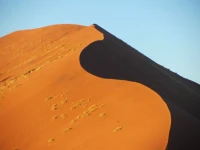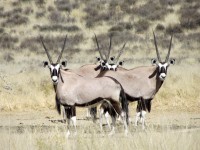The Brandberg in Namibia is one of the most arid environments I have ever been in. All the plants and animals have had to adapt to the lack of water, but contrary to what one expect, there is a lot of life here. There is a more detailed introduction to the area in the post The White Lady of Brandberg.
While we were in the area, we stayed at the Brandberg White Lady Lodge. Which sounds a lot fancier than it is. What did impress me was their desert garden. Instead of trying (probably unsuccessfully) to grow “normal” garden plants, the whole garden is a mass of aloes, succulents and other plants which can handle the lack of water and the harsh sunlight.

Approaching the Brandberg. Literally a burnt mountain. In the foreground a pile of rocks and a dead tree with crows perched ominously on it. ©LB/notesfromafrica.wordpress.com

©LB/notesfromafrica.wordpress.com
The area around the lodge actually had some greenery – shrubs and a couple of trees.

©LB/notesfromafrica.wordpress.com
And now onto the garden which was carefully arranged in little clusters of aloes and succulents, with walkways in-between. The variety was stunning. There was also the odd palm tree for shade.

©LB/notesfromafrica.wordpress.com

©LB/notesfromafrica.wordpress.com

There was certainly enough natural rock around to line the walkways and “flower beds”. ©LB/notesfromafrica.wordpress.com

©LB/notesfromafrica.wordpress.com

©LB/notesfromafrica.wordpress.com

©LB/notesfromafrica.wordpress.com

©LB/notesfromafrica.wordpress.com

©LB/notesfromafrica.wordpress.com

©LB/notesfromafrica.wordpress.com

©LB/notesfromafrica.wordpress.com

This looked like a dead tree to me – or maybe it had just dropped its leaves during the winter? ©LB/notesfromafrica.wordpress.com
Besides the plants, the garden was decorated with artwork. There were elephants made of some kind of natural fibre/grass and little twigs. There were animals carvings made from dead tree limbs. And then there were some live animals too. There were lots of birds in the garden as well as two tame meerkats who chased each other around at high speed.

©LB/notesfromafrica.wordpress.com

©LB/notesfromafrica.wordpress.com

©LB/notesfromafrica.wordpress.com

Old tree stump tortoise? ©LB/notesfromafrica.wordpress.com

Tree stump baboon? You have to use your imagination! ©LB/notesfromafrica.wordpress.com

The two very tame meercats who live at the lodge. ©WMB/notesfromafrica.wordpress.com

A live one! ©LB/notesfromafrica.wordpress.com
The main lodge building also had a lot of artwork – mosaics and wooden carvings.

The veranda leading off from the dining room. ©LB/notesfromafrica.wordpress.com

A lizard inside the lodge. ©LB/notesfromafrica.wordpress.com

©LB/notesfromafrica.wordpress.com

©LB/notesfromafrica.wordpress.com

©LB/notesfromafrica.wordpress.com

Our little cottage. ©LB/notesfromafrica.wordpress.com
This post is part of a series I will be publishing about our travels through Namibia.


















The garden is very special and artistic. So interesting to read and see these kind of places.
Yes, there was a lot of thought that went into making the garden. I think the artwork was done by local crafters.
The flora is very reminiscent of our southwest. I kept expecting to see a few ironwood trees, the only tree that can survive the heat and dryness of the Sonoran desert. It looks so beautiful in that bleak way that deserts are beautiful.
Willie and I both love deserts – spend a lot of our vacations in them.
We don’t have the Desert Ironwoods here, but a tree which does grow on the mountain is Olea europaea subsp. cuspidata known commonly here as the Wild Olive or Iron Tree. So in a completely different family of trees to the Desert Ironwood, but is also listed under the “ironwoods“. One of those examples again where harsh environments have caused very similar plants to develop on different continents.
What an extraordinary garden! In Cape Town, we’re so used to seeing ‘English-style’ or ‘cottage’ gardens, with lots of lush green foliage and riots of colourful flowers at various times of year – but gardening like that tends to be more water-intensive. So seeing what is possible to grow in an arid desert environment with extremes of temperature – and a lot of rocks! – is seriously inspiring. Given our water restrictions and the extended drought in SA, we will need to adapt by changing what kinds of plants we put into our garden. I really love the works of art – particularly those big animals out of natural grasses and twigs – magical!
I also found it fascinating to see what could be done in such a dry area. There is a house in our neighbourhood where the owners have planted succulents, cacti, aloes, various reeds etc. Besides not needing much water, it is a vey low maintenance garden.
Very nice, those small flowers in the fifth photo, we have them in South India too, we call them Nitya Pushpa, Nitya means always and Puspa is flower.
So interesting to hear that we have wild flowers in common. Thanks for visiting and for your comment! 🙂